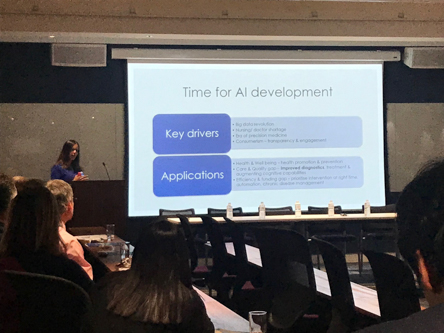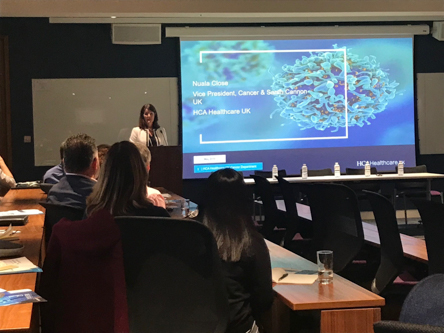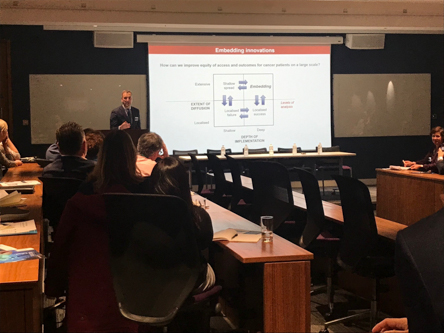Innovation in Cancer Care in the spotlight at CHIR and Bupa event
The Centre for Healthcare Innovation Research (CHIR) teams up with leading healthcare provider Bupa to deliver Innovation in Cancer Care event.
The Centre for Healthcare Innovation Research (CHIR) and Bupa UK brought together some of the United Kingdom's leading healthcare practitioners and researchers for their first co-sponsored event.
In the surrounds of Cass Business School's Executive Education Campus, representatives from the NHS, Check4Cancer, Bupa UK, HCA Healthcare UK and the CHIR discussed the event topic 'Innovation in Cancer Care: The journey to improved outcomes for all'.
Dr Luke James, Medical Director of Bupa UK Insurance began proceedings by welcoming guests and speakers to the first in a series of co-hosted events and setting the tone for the evening.
"There have been significant improvements in technology, and the screening, detection and treatment of cancer in the last decade," Dr James said.
"Tonight we plan to discuss some of those and how they can and already do help us in delivering high-quality expert care to people diagnosed with cancer."
Artificial intelligence in cancer screening
Following Mr James at the lectern was Dr Amrita Kumar, Consultant Radiologist and Breast Screening Specialist at the Frimley Health NHS Foundation Trust.
Dr Kumar's presentation 'The future of Breast Cancer care through AI and technology: practical applications' discussed the positives and negatives of breast cancer screening as it is currently performed, revealing that the breast radiology sector is facing a skills shortage with the number of vacant positions in the field doubling since 2010.
She suggested that developments in artificial intelligence (AI) technology had the ability to expedite cancer diagnoses in some cases, exciting her and her colleagues, but said healthcare providers had a responsibility to further the reach and abilities of the technology.

"All healthcare operations need to be early adopters of AI ... this will lead to improved patient outcomes," Dr Kumar said.
"In terms of breast cancer the idea is to have AI or machine technology come in as the second reader of a scan so we still have the human interaction first.
"Patients want the right diagnoses at the right time and the right treatment to follow."
Direct pathways improving patient outcomes
Continuing the discussion around innovations in the cancer screening process Dr Gordon Wishart, founder of early cancer detection service Check4Cancer, delivered his presentation 'Embedding innovation in early diagnosis and screening'.
Dr Wishart explained the difference innovations in the pathways patients use to report suspected skin and breast cancers had made to overall outcomes, both clinically and in terms of patient satisfaction levels.
"Through direct pathways to specialists, as opposed to GP referrals, cancer diagnoses can be made or ruled out much faster," Dr Wishart said.
"I spend most of my career diagnosing and treating people with cancer so the earlier we discover it and start treating it the better it is for everyone."
Ian Culligan, Clinical Change Manager for Bupa UK Insurance, continued to champion the success of direct pathway models, comparing average wait times for NHS patients with those experienced by Bupa clients.
Mr Culligan said people concerned by symptoms of cancer could wait weeks for a diagnosis through the NHS, and some that are confirmed as having cancer can wait more than two months to begin treatment.
"Some people are reassured during their first phone call to us that their symptoms are not signs of cancer, but even the small amount of people who are diagnosed following consultation are reassured that they've detected it early," he said.
"And once someone's diagnosed we're there to make sure their care is clinically effective."
Technology key to rapid access, rapid diagnosis
Nuala Close, Vice President of Cancer and Sarah Cannon Cancer Research Institute UK, reiterated the importance of early diagnoses for cancer patients – not only in terms of their clinical treatment, but also for their mental health and that of their families and friends.
"Rapid access is really, really important ... these people are worried and they want to be seen quickly," Ms Close said.
She went on to explain that with advances in technology, and the direct pathways explained by the previous two speakers, cancer diagnoses could often be made within 48 hours of the patient's initial contact with their provider.

Ms Close said she believed technology would soon have similar effects on treating cancer as it has had on diagnosing it, but stressed that humans need to retain overall control.
"Robotics is likely the way of the future but you need someone who is using robots a lot - you don't want someone delving into robotic surgery who only uses the robot periodically - and you need a team of clinical staff behind them to make it all work well," she said.
Spreading innovation across the industry
The final speaker of the evening was Dr Yiannis Kyratsis, Co-Director of the CHIR, who outlined the challenges the UK's healthcare industry faces in successfully embedding innovations in cancer care.
"In the last 40 years there have been huge improvements in screening, diagnoses and treatment of cancer and in some cases survival rates have doubled," Dr Kyratsis said.
"But when it comes to surviving cancer the UK still lags behind comparable countries."
Dr Kyratsis said the UK's lag could, in part, be because of the difficulty of replicating successful innovations in other areas or settings or on a larger scale.
"There is a real challenge in spreading innovations equally across the UK and there is a real challenge in scaling up successes that are proven," he said.
Dr Kyratsis then detailed the disparity in the NHS budget for research and development of innovations compared to spreading and implementing innovation.
"One-point-two billion pounds is spent on research and development but only 50-million pounds is spent on spreading it across the country," he said.
"The fact that 24-times less is spent on the spread of innovation shows that it is not being taken seriously.
"When you embed innovation well you make it routine, you make it institutionalised and you make it stable."
